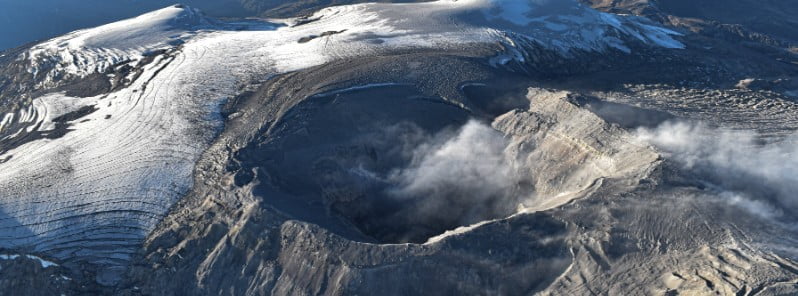Nevado del Ruiz – Evacuations in progress after seismicity increases to levels not seen since major eruption in 1985, Colombia

Colombian officials began to evacuate people living on the slopes of the Nevado del Ruiz volcano on Monday, April 3, 2023. The decision follows the highest levels of seismicity since the 1985 eruption (VEI 3) when 25 000 people were killed.
A vigorous eruption took place at the volcano at 14:02 UTC on March 20, 2023, but Colombia’s Geological Service (SGC) kept the Alert Level on Yellow — the second lowest level on a four-color scale — until March 30 when it raised it to Orange for the first time since 2012.
According to the SGC, daily seismic activity began to increase sharply on March 24 when more than 9 400 earthquakes were recorded. On March 25, the number of earthquakes increased above 11 000, marking the highest recorded number since the 1985 eruption.
Through the end of March, an average of 9 000 earthquakes were registered per day. “[This is] unprecedented in the time that we have been monitoring volcanoes in Colombia,” SGC said.
In addition, since October 2022 there has been a persistence of thermal anomalies in the volcano’s crater, which have been detected through satellites. Therefore, this permanence of material near the surface indicates a possible intrusion of magma coming from the south, at depths of about 3 km (1.8 miles).
On April 2, 5 400 seismic events were registered. 5 of them had a magnitude of 2.0 and one 2.3. The maximum height of the column of gases and/or ash observed on April 3 was 1 200 m (4 000 feet) measured from the top of the volcano.
Along with raising the Alert Level to Orange, SGC warned there is a possibility of an eruption bigger than any in the past 10 years in the coming days or weeks.
As a result, officials closed the National Natural Park Los Nevados and started the preventive evacuation of residents who live near the summit of the active volcano. In addition, all schools located within 10 km (6 miles) of the volcano’s crater will hold classes online when children return home from the Easter holidays next week.
An estimated 30 communities along a volcanic belt that extends through the departments of Tolima, Caldas, and Antioquia could be affected by the eruption, including towns in the Magdalena River basin.
The community is urged to remain calm, but be attentive to the information provided by the SGC on the evolution of the state of the volcano.
“Just as it is not possible scientifically to know exactly when a volcano will erupt, it is also not possible to know precisely what that eruption would be like,” SGC said.
“What we know is that Nevado del Ruiz is an explosive type volcano (its eruptions imply the fracturing of rock and the expulsion of it together with gases and fluids at high speeds and temperatures), whose most recent eruptive history marked us as a country with the Armero tragedy, which left 25 000 people dead. In that eruption, the volcanic phenomena that occurred were mostly lahars or mudflows, as well as ash fall and pyroclastic flows.”
This is one of the most active volcanoes in Colombia. It is located in the Andes mountain range, with an elevation of 5 279 m (17 320 feet).
The last time its Alert Level was raised to Orange was in 2012. It was kept at orange for over a month in April and increased to Red for two days in June. However, no major eruption occurred and the Alert Level was later lowered to Yellow.
Geological summary
Nevado del Ruiz is a broad, glacier-covered volcano in central Colombia that covers more than 200 km2 (77.22 mi²). Three major edifices, composed of andesitic and dacitic lavas and andesitic pyroclastics, have been constructed since the beginning of the Pleistocene.
The modern cone consists of a broad cluster of lava domes built within the caldera of an older edifice. The 1 km (0.62 mi) wide and 240 m (787.4 feet) deep Arenas crater occupies the summit.
The prominent La Olleta pyroclastic cone located on the SW flank may also have been active in historical time. Steep headwalls of massive landslides cut the flanks.
Melting of its summit icecap during historical eruptions, which date back to the 16th century, has resulted in devastating lahars, including one in 1985 that was South America’s deadliest eruption.
References:
1 Qué está pasando en el volcán Nevado del Ruiz? – SGC – April 1, 2023
2 Volcán Nevado del Ruiz – Bulletins archive – SGC – March/April 2023
3 Colombia’s Nevado del Ruíz remains on orange alert for eruption – The City Paper Bogota – April 3, 2023
4 Nevado del Ruis – Geological summary – GVP
Featured image credit: SGC

Commenting rules and guidelines
We value the thoughts and opinions of our readers and welcome healthy discussions on our website. In order to maintain a respectful and positive community, we ask that all commenters follow these rules.